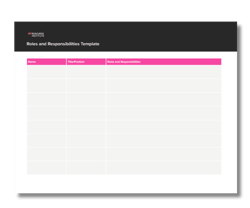6 min read
Creating Team Alignment: DIY Team Building Workshop
Leading a team can sometimes feel like herding feral cats when trying to get everyone focused on the same mission, aligned on priorities, and moving...
4 min read
 Michelle Bennett
:
Feb 1, 2024 5:00:00 AM
Michelle Bennett
:
Feb 1, 2024 5:00:00 AM
.png)
Would your team members say, “I know what is expected of me at work”?
Gallup has spent the last thirty years researching this topic by evaluating employee surveys and tracking their results. They found that employees who could answer, “I know what is expected of me at work,” correlated with productivity increases of 5-10%, thousands more happy customers, and 10-20% fewer accidents on the job.
A team with clear roles and responsibilities is like, according to Gallup, “A great jazz band in which each player listens to the other instruments as he plays his own.” To get that kind of team, it’s up to the leaders to ensure that each team member has clearly defined expectations, accountabilities, and an understanding of how their role fits in and contributes to the team’s success.This aligns with the principles discussed in the Expectancy Theory of Motivation, which underscores how clear expectations can enhance motivation and overall team performance.
In this article, we will explore the importance of role clarity, strategies to help team leaders define roles and responsibilities, and a template to record it all. By implementing these practices, you can create a harmonious and high-performing team that knows what’s expected of them and how to achieve its goals.
Jump to:
Clear and well-defined roles and responsibilities benefit the team as a whole and individual team members. Effectory explored the positive benefits found in employees with high role clarity, that is, clearly understanding their own roles and responsibilities. Here is what they found:
.png?width=1000&height=563&name=86%25%20of%20employees%20with%20high%20role%20clarity%20report%20high%20levels%20of%20effectiveness.%20(1).png)
Effectively defining roles and responsibilities is a critical aspect of team leadership. Clear expectations and well-defined roles lead to increased productivity, accountability, and collaboration within the team, as everyone understands how they contribute.
If you’re looking for a thoughtful and systematic approach to defining team roles and responsibilities, here are the nine steps you must take.
.png?width=1000&height=628&name=7%20Steps%20to%20Defining%20Team%20Roles%20and%20Responsibilities%20(1).png)
The first step is to take a macro look at your team by determining the team vision and team goals. Clearly defined vision and goals are the foundation for defining the team roles and responsibilities to achieve the desired outcomes. To ensure your goals are actionable and achievable, you will want to use a SMART goals template to define them.
After the team vision and goals are crystal clear, you will need to break down the goals into specific tasks and requirements that need to take place to achieve them. You’ll need to identify the necessary skills, expertise, and competencies for each task.
Now that you have broken down each task with the necessary skills, expertise, and competencies needed to complete it, the next step is to match individuals based on their strengths and expertise to each task. You’ll want to match strengths to each task instead of trying to fix an individual’s deficiencies to meet them. When individuals can utilize their strengths at work, Gallup has found that they’re more engaged, perform better, are less likely to leave, and contribute more to bottom-line results.
After you’ve matched each individual's strengths to the tasks needing to be performed, the different roles each team member will play will become clear. You will want to formalize each role by recording, sharing, and clearly communicating each team member's role and responsibilities to the group.
Each role will have its own expectations and accountabilities that must be met. Here, you will outline the specific tasks, deliverables, deadlines, quality standards, and outcomes associated with each responsibility. In addition, every individual must understand the accountabilities of their teammates as each individual’s contributions impact the larger team goal and their peers’ ability to achieve their accountabilities.
Now, it’s time to hand over the floor to team members to discuss their roles and how each role is interconnected. Doing so will help ensure everyone fully understands their roles and those of their teammates. You’ll want to jump in and address any questions or concerns and provide clarity if needed.
In addition, running a team alignment workshop will provide an extra level of clarity on goals and roles and an opportunity for teammates to decide on critical success factors such as goal milestones, team values, communication expectations, and barriers that could hold the team back.
Changes will inevitably need to be made based on progress, feedback, changing priorities, or new opportunities. You’ll want to periodically review team roles and responsibilities to ensure they remain aligned with the team’s goals and evolving needs and adjust them accordingly.
Moreover, you’ll want to check in with each team member during their one-on-one meetings to ensure they understand their roles, address concerns, and provide coaching as needed.
Defining clear roles within a team is essential for efficient collaboration and goal achievement. When team members understand their responsibilities, they can work more effectively and avoid confusion.
Managing team roles requires open communication, fostering collaboration, and using the right tools. By following best practices, leaders can create a well-structured and high-performing team.
Open communication ensures that everyone understands their roles and how they fit into the team. Giving feedbacks helps team members align with their responsibilities and make necessary adjustments. Encourage an environment where team members feel comfortable sharing ideas and concerns. Clear, honest communication builds trust and helps resolve issues quickly.
A collaborative team environment allows individuals to leverage each other's strengths. Encourage teamwork by promoting shared goals and cross-functional collaboration. Regular team meetings and discussions help align efforts and improve workflow. Fostering collaboration leads to better problem-solving and innovation within the team.
Technology can simplify the process of assigning and managing team roles. Project management tools allow leaders to track progress, assign tasks, and adjust roles as needed. These tools ensure that everyone stays informed and accountable. Using the right technology streamlines communication and enhances team productivity.
 To streamline the process of defining roles and responsibilities, use this Roles and Responsibilities Template, as it will provide you with a structured framework for documenting all the necessary information. You’ll want to include the team alignment worksheet with the roles and responsibilities template to have a holistic view of what the team wants to achieve and how they will do so.
To streamline the process of defining roles and responsibilities, use this Roles and Responsibilities Template, as it will provide you with a structured framework for documenting all the necessary information. You’ll want to include the team alignment worksheet with the roles and responsibilities template to have a holistic view of what the team wants to achieve and how they will do so.
.png)
6 min read
Leading a team can sometimes feel like herding feral cats when trying to get everyone focused on the same mission, aligned on priorities, and moving...

8 min read
As Henry Mintzberg, Canadian academic and author on business and management, put it, “Management is, above all, a practice where art, science, and...
.png)
8 min read
When was the last time you or your team stepped back and learned from an experience or situation at work? For many who are fighting to meet tight...